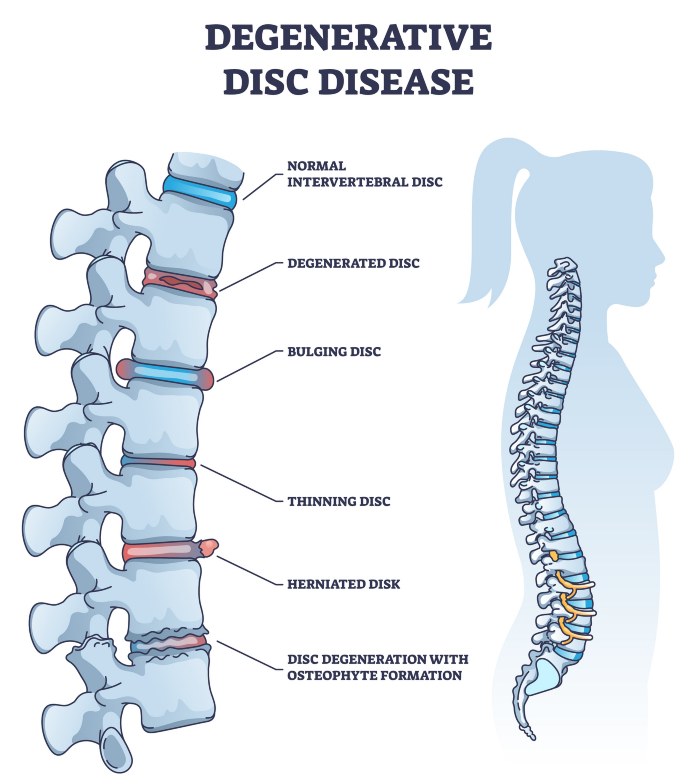Spinal health is something most people don’t think about—until chronic back pain begins to interfere with daily life. One common culprit is degenerative disc disease (DDD), a condition that affects millions of Americans and becomes more common with age. At Greater Maryland Pain Management, we believe education is the first step to effective care. In this blog, we’ll break down the degenerative disc disease stages, the symptoms to look for, and what treatment options can help manage pain and slow the disease’s progression.

What Is Degenerative Disc Disease?
Despite its name, degenerative disc disease is not technically a disease but a condition caused by the natural wear and tear of the spinal discs over time. These rubbery cushions between your vertebrae lose hydration and elasticity with age, reducing their ability to absorb shock and support movement.
While some people may never experience pain, others suffer from chronic disc pain, stiffness, or nerve-related symptoms that impact quality of life. Understanding where you are in the progression of spinal disc degeneration can help you choose the right treatment path.
Stage 1: Early Disc Degeneration
This is where the changes begin—but they’re often easy to ignore.
What’s Happening in Your Spine:
- Discs start to lose water content
- Flexibility decreases slightly
- Small cracks may appear in the outer layer of the disc
Symptoms:
- Mild, on-and-off back pain
- Stiffness, especially after sitting or sleeping
- Fatigue in your back muscles after activity
Treatment Options:
At this stage, conservative approaches are typically effective:
- Physical therapy to strengthen supporting muscles
- Nonsteroidal anti-inflammatory drugs (NSAIDs)
- Lifestyle modifications such as weight loss, posture correction, and ergonomic changes
- Personalized movement and stretching programs
Why It Matters: Catching the early signs of disc disease gives you the best chance to slow progression naturally.
Stage 2: Disc Bulging and Instability
This stage is where symptoms usually become harder to ignore.
What’s Happening in Your Spine:
- Discs continue to shrink
- Bulging discs may press on nearby nerves
- The spine may begin to lose stability
Symptoms:
- More frequent or sharp pain
- Pain that radiates into the hips, thighs, or shoulders
- Tingling or numbness in your arms or legs
- Trouble bending or lifting without discomfort
Treatment Options:
This stage often calls for a multi-modal approach:
- Interventional pain procedures, such as epidural steroid injections or facet joint blocks
- Prescription medications for nerve pain or inflammation
- Continued physical therapy with a focus on stabilization
- Imaging (MRI) to track progression
Stage 3: Disc Herniation and Chronic Pain
At this point, spinal disc degeneration can become a daily struggle.
What’s Happening in Your Spine:
- Discs have significantly lost height
- Herniated discs may press directly on nerves
- Vertebrae may shift or become misaligned
Symptoms:
- Constant lower back or neck pain
- Sciatica (pain radiating down one leg)
- Muscle weakness or loss of coordination
- Pain that gets worse with movement, coughing, or sneezing
Treatment Options:
This stage often requires more advanced interventions:
- Image-guided injections (e.g., transforaminal epidural injections)
- Radiofrequency ablation for nerve pain
- Targeted medications, including muscle relaxants or nerve blockers
- Spinal decompression therapy
This is where personalized care really matters. National pain clinics often push standard protocols, but we believe pain care should never be one-size-fits-all. At our Maryland clinics, you get a customized, hands-on approach.
Stage 4: Disc Collapse and Degenerative Instability
This is the most advanced of the degenerative disc disease stages, and the symptoms can deeply affect daily life.
What’s Happening in Your Spine:
- Discs may completely collapse
- Bone-on-bone contact between vertebrae
- Spinal stenosis (narrowing of the spinal canal) often occurs
Symptoms:
- Severe, chronic disc pain
- Difficulty walking, standing, or sleeping
- Loss of mobility or balance
- Numbness, weakness, or “pins and needles” in arms or legs
Treatment Options:
- Advanced interventional techniques (spinal cord stimulation or intrathecal pain pumps)
- Customized pain medication regimens
- Physical therapy focused on mobility and strength
- Lifestyle and assistive modifications to improve quality of life
Even in advanced stages, chronic disc pain management can be successful with the right combination of physician-guided strategies.
Why Early Diagnosis Matters
Catching disc degeneration early gives you more treatment options and a better chance at slowing progression. Whether you’re just starting to notice stiffness in the morning or have been dealing with recurring back pain for years, a proper diagnosis can put you on the path to relief. Common early signs of disc disease include:
- Dull, localized back pain
- Pain that improves with rest
- Discomfort with prolonged sitting or standing
If this sounds familiar, it’s time to talk to a specialist who can help you understand where you are in the degenerative disc disease stages and what steps to take next.
Personalized Disc Disease Treatment Options in Maryland
Greater Maryland Pain Management offers a full range of disc disease treatment options, from conservative therapies to cutting-edge interventions. What sets us apart?
- Physician-led care at every stage
- Customized treatment plans based on imaging and patient goals
- Local expertise backed by compassionate, one-on-one support
- Convenient Maryland locations and minimal wait times
We’re proud to offer a higher standard of care than many national providers, who may rely on generalized protocols and hand-offs to mid-level staff. Your spine deserves focused attention from an expert.
Don’t Let Disc Degeneration Define You
Degenerative disc disease may be a natural part of aging, but chronic pain doesn’t have to be. Whether you’re in the early stages of spinal disc degeneration or facing complex symptoms, our team is here to help. Let’s work together to manage your pain, protect your mobility, and improve your quality of life, starting today.
Contact us at Greater Maryland Pain Management to schedule a consultation and learn more about your Degenerative disc disease stage and treatment options. Relief is closer than you think.